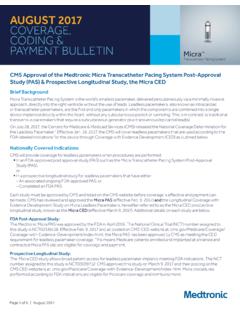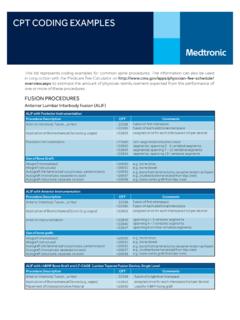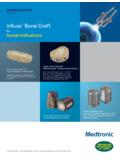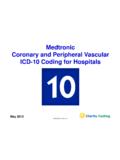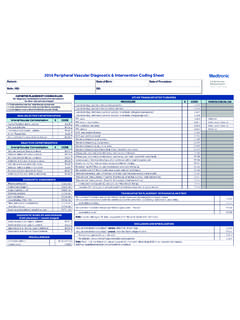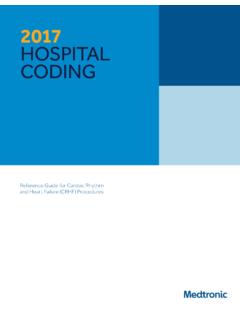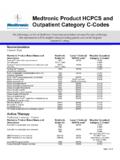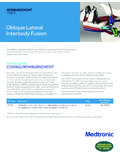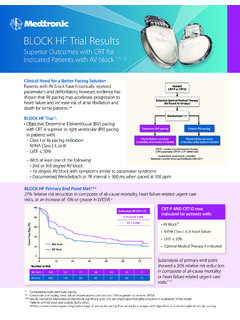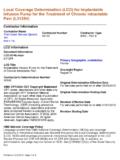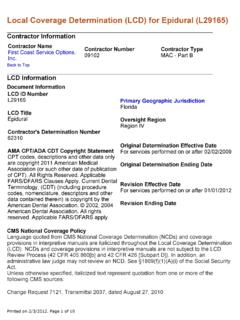Transcription of MEDTRONIC COMMONLY BILLED CODES
1 MEDTRONIC COMMONLY BILLED CODES TARGETED DRUG DELIVERY FOR chronic pain EFFECTIVE JANUARY 2018 2 MEDTRONIC provides this information for your convenience only. It does not constitute legal advice or a recommendation regarding clinical practice. Information provided is gathered from third-party sources and is subject to change without notice due to frequently changing laws, rules and regulations. The provider has the responsibility to determine medical necessity and to submit appropriate CODES and charges for care provided. MEDTRONIC makes no guarantee that the use of this information will prevent differences of opinion or disputes with Medicare or other payers as to the correct form of billing or the amount that will be paid to providers of service.
2 Please contact your Medicare contractor, other payers, reimbursement specialists and/or legal counsel for interpretation of coding, coverage and payment policies. This document provides assistance for FDA approved or cleared indications. Where reimbursement is sought for use of a product that may be inconsistent with, or not expressly specified in, the FDA cleared or approved labeling (eg, instructions for use, operator s manual or package insert), consult with your billing advisors or payers on handling such billing issues. Some payers may have policies that make it inappropriate to submit claims for such items or related service. The following information is calculated per the footnotes included and does not take into effect Medicare payment reductions resulting from sequestration associated with the Budget Control Act of 2011.
3 Sequestration reductions went into effect on April 1, 2013. ICD-10-CM1 chronic pain Diagnosis CODES Diagnosis CODES are used by both physicians and hospitals to document the indication for the procedure. Targeted Drug Delivery is directed at managing chronic , intractable pain . pain can be coded and sequenced several ways depending on the documentation and the nature of the encounter. CODES from the G89 series are used as the principal diagnosis when the encounter is for pain control or pain management, rather than for management of the underlying condition. Additional CODES may then be assigned to give more detail about the nature and location of the pain and its underlying cause. When a specific pain disorder is not documented or the encounter is to manage the cause of the pain , the underlying condition is coded and sequenced as the principal chronic pain Disorders Central pain syndrome Other chronic pain Neoplasm related pain (acute)( chronic ) chronic pain syndrome Note: pain must be specifically documented as chronic to use code Similarly, the diagnostic term chronic pain syndrome must be specifically documented to assign code If these terms are not documented, then symptom CODES for pain may be assigned instead, although they cannot be sequenced as principal diagnosis.
4 Rather, the underlying condition would ordinarily be used as the principal diagnosis in this circumstance. Reflex Sympathetic Dystrophy (RSD) (Complex Regional pain Syndrome I, CRPS I) and Causalgia (Complex Regional pain Syndrome II, CRPS II) Complex regional pain syndrome I of right lower limb Complex regional pain syndrome I of left lower limb Note: ICD-10-CM does not have a default code for Complex Regional pain Syndrome ; type I or II must be specified. pain CODES from the G89 series in ICD-10-CM should not be assigned separately with the CODES for reflex sympathetic dystrophy or causalgia because pain is a known component of these disorders. Complex regional pain syndrome I of lower limb, bilateral Causalgia of unspecified lower limb Causalgia of right lower limb Complex regional pain syndrome I of unspecified lower limb Causalgia of bilateral lower limbs Causalgia of left lower limb For questions please contact us at CHART CONTINUED ON NEXT PAGE 3 ICD-10-CM1 chronic pain Diagnosis CODES continued Underlying Causes of chronic pain (Non-Cancer)
5 Postherpetic Neuropathy Postherpetic trigeminal neuralgia Postherpetic polyneuropathy Arachnoiditis chronic meningitis Meningitis, unspecified Phantom Limb pain Phantom limb syndrome with pain Peripheral Neuropathy Unspecified mononeuropathy of unspecified lower limb Unspecified mononeuropathy of right lower limb Unspecified mononeuropathy of left lower limb Unspecified mononeuropathy of bilateral lower limbs Radiculopathy Intervertebral disc disorders with radiculopathy, lumbar region Intervertebral disc disorders with radiculopathy, lumbosacral region Radiculopathy, lumbar region Radiculopathy, lumbosacral region Osteoporosis-Related Fracture, Vertebra3 Age-related osteoporosis with current pathological fracture, vertebra(e) Other osteoporosis with current pathological fracture, vertebra(e) Postlaminectomy Syndrome Postlaminectomy syndrome, not elsewhere classified Other postherpetic nervous system involvement TARGETED DRUG DELIVERY COMMONLY BILLED CODES CHART CONTINUED ON NEXT PAGE 4 ICD-10-CM1 chronic pain Diagnosis CODES continued Underlying Causes of chronic pain (Cancer)
6 4 Malignant neoplasm of esophagus Malignant neoplasm of stomach , C19, C20, , Malignant neoplasm of colon, rectosigmoid junction, rectum, and anus , Malignant neoplasm of liver Malignant neoplasm of pancreas C33, Malignant neoplasm of lung, bronchus and trachea , Malignant neoplasm of bones Malignant neoplasm of breast Malignant neoplasm of cervix , C55 Malignant neoplasm of uterus Malignant neoplasm of ovary C61 Malignant neoplasm of prostate Malignant neoplasm of testis , , Malignant neoplasm of kidney , Malignant neoplasm of bladder Malignant neoplasm of brain, spinal cord, and other central nervous system structures Pathological fracture in neoplastic disease, other specified site (vertebrae)3 TARGETED DRUG DELIVERY COMMONLY BILLED CODES CHART CONTINUED ON NEXT PAGE 5 ICD-10-CM1 Other Diagnosis CODES for chronic pain Device Complications3,5,6 Breakdown (mechanical) of cranial or spinal infusion catheter Breakdown (mechanical)
7 Of other nervous system device, implant or graft Displacement of cranial or spinal infusion catheter Displacement of other nervous system device, implant or graft Leakage of cranial or spinal infusion catheter Leakage of other nervous system device, implant or graft Other mechanical complication of cranial or spinal infusion catheter Other mechanical complication of other nervous system, implant, or graft Infection and inflammatory reaction due to cranial or spinal infusion catheter Infection and inflammatory reaction due to other nervous system device, implant, or graft Hemorrhage due to nervous system prosthetic devices, implants, and grafts pain due to nervous system prosthetic devices, implants and grafts Other specified complication of nervous system prosthetic devices, implants and grafts7 Attention to Device8 Encounter for adjustment and management of other implanted nervous system device 1.
8 Centers for Disease Control and Prevention, National Center for Health Statistics. International Classification of Diseases, Tenth Revision, Clinical Modification (ICD-10-CM). Updated October 1, 2017. Accessed November 21, 2017. 2. ICD-10-CM Official Guidelines for Coding and Reporting FY 2018, 3. Fracture and device complication CODES ending in A are technically defined as initial encounter but continue to be assigned for each encounter in which the patient is receiving active treatment for the facture or complication (ICD-10-CM Official Guidelines for Coding and Reporting FY 2018, ). 4. The most common anatomic sites for primary and secondary cancer are displayed. CODES for other sites are also available within code range C00-C96.
9 5. When a device complication is the reason for the encounter, the device complication code is sequenced as the primary diagnosis followed by a code for the underlying condition. If the purpose of the encounter is directed toward the underlying condition or the device complication arises after admission, the underlying condition is sequenced as the primary diagnosis followed by the device complication code. 6. According to ICD-10-CM manual notes, CODES defined for cranial or spinal infusion catheter include intrathecal and subarachnoid infusion catheters, and CODES defined for other nervous system device, implant or graft include intrathecal infusion pumps. 7. According to ICD-10-CM manual notes, other specified complication includes erosion or breakdown of a subcutaneous device pocket.
10 8. ICD-10-CM code is used as the principal diagnosis when patients are seen for routine device maintenance, such as periodic pump device checks and programming, as well as routine device replacement. A secondary diagnosis code is then used for the underlying condition. (See also Coding Clinic, 2nd Q 2014, ) TARGETED DRUG DELIVERY COMMONLY BILLED CODES 6 ICD-10-PCS1 Procedure CODES Hospitals use ICD-10-CM procedure CODES for inpatient services. Trial and Catheter Procedures Catheter Implantation2,3 00HU33Z Insertion of infusion device into spinal canal, percutaneous approach Intrathecal Injection 3E0R3NZ Introduction of analgesics, hypnotics, sedatives into spinal canal, percutaneous approach Catheter Procedures Catheter Implantation2,3 00HU33Z Insertion of infusion device into spinal canal, percutaneous approach Intrathecal Injection 3E0R3NZ Introduction of analgesics, hypnotics, sedatives into spinal canal, percutaneous approach Catheter Removal4 00PU03Z Removal of infusion device from spinal canal, open approach 00PU33Z Removal of infusion device from spinal canal.
